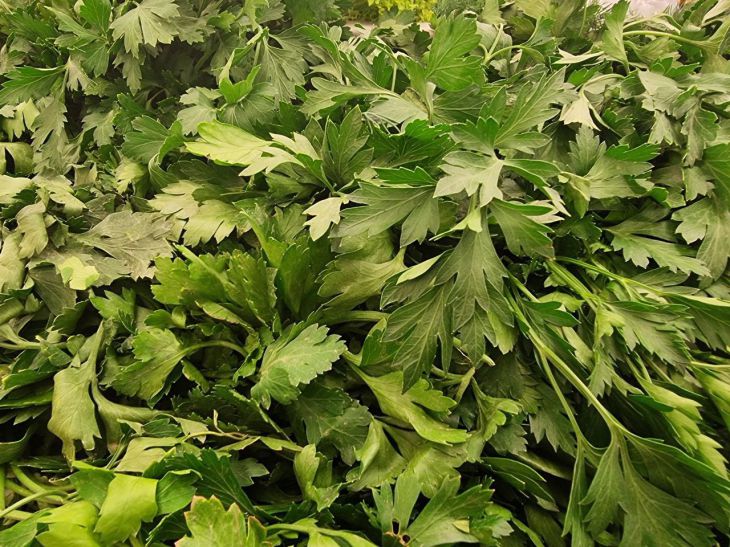Fragrant parsley: what are the nuances of sowing and growing
Many gardeners face difficulties when growing this crop. Sometimes the seeds take a long time to germinate, sometimes the shoots stretch out and fall out.
The reason for this is the peculiarities of parsley agricultural technology. Knowing its secrets, you will be able to get luxurious harvests year after year.
Today we will reveal the main nuances of sowing parsley. We will tell you how to properly prepare seeds, soil and beds, says Anastasia Kovrizhnykh .
We will share the sowing time and the depth of seed placement. We will figure out how to care for seedlings and adult plants. You will learn everything about spicy greens from A to Z!
Biological characteristics of the culture
To understand the intricacies of growing parsley, you must first understand its nature.

This spicy herb is a cold-resistant plant of biennial culture. In the first year, a rosette of leaves is formed, in the second year, flower stalks are formed, seeds are formed and the plant dies.
Parsley has a taproot that goes into the soil to a depth of 1 meter. The powerful root system provides the plant with moisture and nutrition during dry periods. Therefore, parsley tolerates short cold spells and frosts down to -5°C.
Parsley seeds are characterized by a deep period of dormancy and do not germinate for a long time. This is an evolutionary self-regulation mechanism that allows the seeds to wait for optimal conditions for germination. In nature, they have to lie in the ground for a whole year before the first shoots appear.
Agronomists have developed varieties of parsley with a shorter period of seed dormancy. However, even these seeds germinate 20-25 days after sowing, and only under optimal conditions. Parsley seedlings are very delicate and easily damaged, so it can be difficult for beginners to work with them.
Preparing seeds to speed up germination
Understanding the biology of this crop, you can significantly speed up the appearance of the first shoots. The main secret of fast, friendly shoots is long-term seed stratification. This is the name of the process of artificial germination.
For stratification, parsley seeds are soaked in a growth stimulator solution for 12-24 hours. Then they are dried, mixed with moistened peat or sawdust and put in the refrigerator for 15-20 days at a temperature of +2...+5°C.
As a result of this procedure, the seeds seem to "think" that they have survived the winter and begin to actively germinate when planted in the ground. After stratification, shoots appear in 5-7 days, instead of the usual 20-25.
If desired, you can make the stratification process easier. To do this, periodically take the box with seeds out of the refrigerator and dry it for several hours at room temperature. This simulates unstable spring climatic conditions.
Preparing the soil and choosing a bed
The success of parsley sowing directly depends on the quality of the soil. This crop prefers fertile, well-aerated soils with a neutral or slightly alkaline reaction.
Parsley does not grow well in acidic, swampy and clayey areas. In heavy soils, its deep roots die from lack of oxygen and stagnant moisture.
Therefore, choose sunny, elevated beds with light, loose sandy or loamy soils for sowing parsley. Be sure to add organic and mineral fertilizers before sowing. This will provide the plants with nutrition for the entire summer period.
Parsley is a great precursor for many crops. It enriches the soil due to its powerful root system and has a beneficial effect on the composition of the soil biocenosis.
Timing and methods of sowing seeds
In central Russia, parsley is sown in open ground in mid-April - early May. In more southern regions, the dates are shifted forward by 2-3 weeks. The crop prefers cool weather conditions with night temperatures up to +5°C. Early sowing provides a longer growing season.
There are two main methods of sowing:
1. Nest. Seeds are sown in holes 5-7 pieces at a depth of 1-1.5 cm, with a distance between nests of 20-25 cm. This method causes less damage to seedlings during thinning.
2. Linear. Seeds are sown in furrows to a depth of 1 cm, with row spacing of 20-25 cm. The yield of greens decreases, but a marketable parsley root crop is formed for long-term storage.
After sowing, be sure to mulch the beds with peat, humus or chopped hay. Mulch prevents crust formation, retains moisture in the surface layer and accelerates the emergence of seedlings.
After 2 weeks of mass germination, weed and thin out the crops, leaving the strongest specimens at a distance of 5-7 cm from each other. With dense plantings, the plants will be skinny and low-growing.
Caring for crops
Parsley is a fairly unpretentious crop to care for. The main thing is to weed in time, regularly loosen the soil and provide moderate watering.
During drought, water consumption reaches 5 liters per 1 sq. m per week. Water early in the morning or in the evening, avoiding moisture getting on the leaf blade. Excessive moisture leads to the death of plants.
Do not forget to feed parsley with complex mineral fertilizers. The first feeding is carried out a month after the emergence of mass shoots. Nitrogen and potassium feedings are repeated every 2-3 weeks.
Greens are harvested 2-2.5 months after sowing. Leaf blades are cut strictly from the base of the rosette along the ground. Do not leave stumps to avoid rotting of the core.
Remember that parsley is a biennial. Already in the second year of life, the leaf rosette becomes hard and rough. During this period, the flower stalk and seeds are actively formed, which are of interest only for subsequent reproduction.
Conclusion
Parsley is an irreplaceable spice for many dishes. The aromatic greens will decorate any table and please your taste buds. Now you know all the secrets of its cultivation from A to Z. Carefully follow agricultural technology, take care of the plants, and then a rich harvest of this fragrant herb is guaranteed! Enjoy the season in the garden!
Previously we reported on the proper care of the fat woman .
